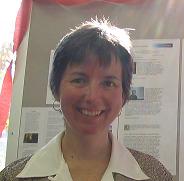
 |
On the Design and Use of Interfaces for Computer-Assisted Orthopedic Surgery Randy E. Ellis |
Computer-assisted surgery is the process of using medical images, such as CT scans, X-ray fluoroscopy, or 3D ultrasound, to improve patient care. A typical surgical procedure begins by acquiring and processing a CT scan with specially developed image-analysis software. A surgeon then performs a "virtual surgery" on the patient to develop a preoperative plan. In the operating room the medical image is registered to the patient, allowing a surgeon to visualize the location of an instrument deep within concealed anatomy while avoiding structures at risk.
For the past decade, our interdisciplinary research group has been investigating fundamental problems in orthopedic surgery of bones and joints. The first part of this talk will be an overview of the problems and solutions that have been tested in a set of pilot clinical trials. The second part will outline the use of storyboards as a fast, effective way to develop user interfaces for new surgical procedures.
Randy E Ellis is a Professor at Queen's University at Kingston. His primary Queen's appointment is in the School of Computing, and he is also appointed as a Professor in the Department of Mechanical Engineering and as a Professor in the Department of Surgery; until August 2006, he was also an Associate Professor in the Department of Radiology at Harvard Medical School. He has worked with surgeons in Canada, the USA, Italy, Sweden, and Saudi Arabia on ways to improve surgical procedures with computer assistance. He is the Project Leader of a large multidisciplinary group that investigates advanced health-care delivery for the coming decade. In the past he has been a Visiting Professor in Computer Science at Johns Hopkins University (Baltimore, MD), a Visiting Scientist at MIT (Cambridge, MA), and a Visiting Associate Professor at the University of Bologna.
The work he leads is jointly funded by the Canada Foundation for Innovation, the Ontario Challenge Fund, the Natural Sciences and Engineering Research Council, and the Canadian Institutes for Health Research Grant. His work involves close collaboration with industrial partners, including Northern Digital (Waterloo, Canada) and General Electric Healthcare.
In addition to more than 100 peer-reviewed scientific papers, his work has been reported on the Canadian Broadcasting Corporation radio and television, the Canadian Television Network, Global Television, numerous trade journals and newspapers (including the national Globe and Mail newspaper), and in NSERC's Report to Parliament.
 |
Designer-Developer Interactions Through Design ArtifactsJudith Brown |
Software programs cannot be perceived. Therefore, in order to develop software, user interface/interaction designers, software developers and other important stakeholders must work through design artifacts. Design artifacts are essential to communication between stakeholders in the design process, a process that encompasses the conception and development of software. This talk is about research on the use of shared design artifacts, the creation of design artifacts, and how to study the usefulness of design artifacts ethnographically. It focuses on the shared artifacts of developers and designers. The talk covers three areas of inquiry spanning a decade of research. The first was an investigation of the work processes of developers and designers. The second was on tool production. In this part of the talk, I describe the principles used to develop a tool in the 90s. This tool was designed to demonstrate a way to support the joint work of designers and developers. The third area of inquiry, which is ongoing, is an in-depth ethnographic study of the collaborative work of designers and developers. Here the talk will focus on design work at a Canadian gaming company, with a particular emphasis on the role that design artifacts play in game development. The talk will describe the analysis of video data conducted with Biddle at Carleton University in Canada, which applied five types of qualitative analysis and also some basic statistical analysis. We found that design work occurs in phases and that design artifacts have a critical role to play. We found that sketches and design stories support creation and reflection and facilitate the resolution of design contradictions, and that lists help to organize design activity. We also found that design artifacts work at a level of consciousness that is below the level of self-awareness. The talk concludes by bringing together the three strands of inquiry by suggesting that a way to support the design activity of designers and developers is to develop shared processes that support joint objectives achieved with tools that support real work activity.
Judith Brown is a PhD candidate in HCI in the Psychology Department at Carleton University. Judith is also a computer scientist (a graduate of Queen’s University in Kingston, Ontario) and taught and researched in the areas of software engineering and human-computer interaction for 15 years at Victoria University of Wellington in New Zealand where she was a senior lecturer. Her research is about design processes and design artifacts and their role in design processes. Judith is an active exec member of CapCHI (an Ottawa branch of SIGCHI) and the Ottawa Usability Consortium (affiliated with the Usability Professional Association). She is also a member of ACM.